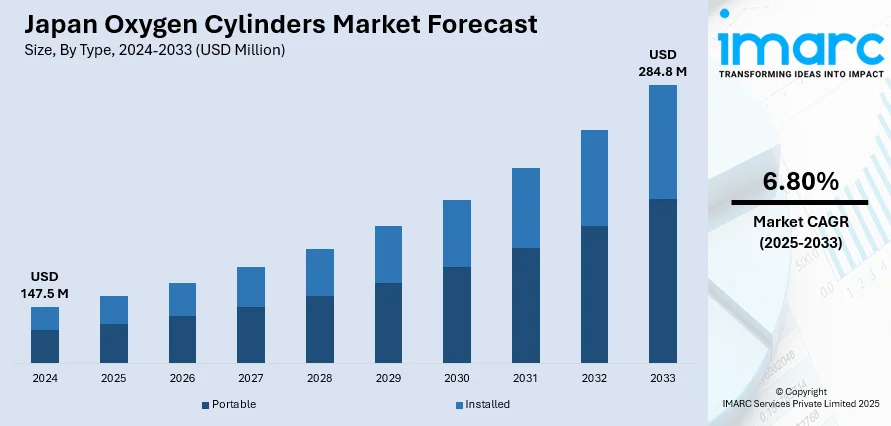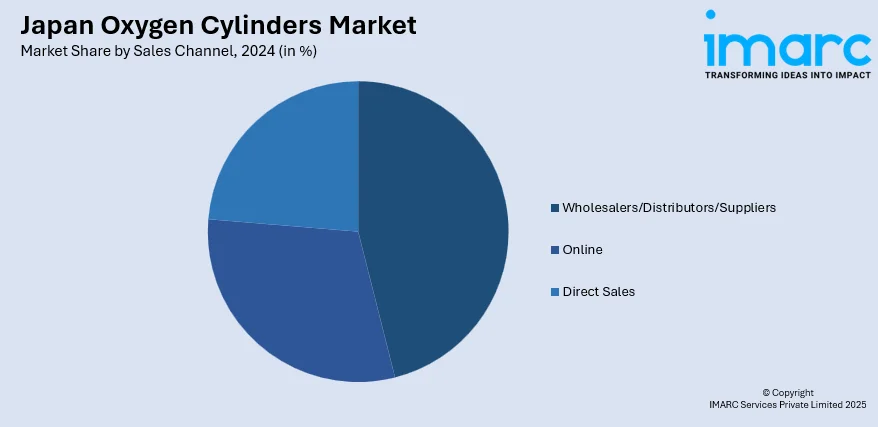
Japan Oxygen Cylinders Market Size, Share, Trends and Forecast by Type, Material Type, Source, Sales Channel, and Region, 2025-2033
Japan Oxygen Cylinders Market Overview:
The Japan oxygen cylinders market size reached USD 147.5 Million in 2024. Looking forward, IMARC Group expects the market to reach USD 284.8 Million by 2033, exhibiting a growth rate (CAGR) of 6.80% during 2025-2033. The market is driven by an aging population requiring respiratory care, increasing cases of chronic conditions like COPD and asthma, and growing urban pollution impacting lung health. Rising demand for home healthcare solutions and advancements in lightweight, portable oxygen technologies are further fueling the Japan oxygen cylinders market share.
|
Report Attribute
|
Key Statistics
|
|---|---|
|
Base Year
|
2024 |
|
Forecast Years
|
2025-2033
|
|
Historical Years
|
2019-2024
|
| Market Size in 2024 | USD 147.5 Million |
| Market Forecast in 2033 | USD 284.8 Million |
| Market Growth Rate 2025-2033 | 6.80% |
Japan Oxygen Cylinders Market Trends:
Aging Population and Chronic Respiratory Conditions
Japan’s aging population is a major driver for the oxygen cylinders market. Elderly individuals are more prone to chronic respiratory diseases like COPD and pulmonary fibrosis, increasing the need for oxygen therapy. As life expectancy rises, more patients require continuous respiratory support at home or in care facilities. The preference for non-hospitalized care solutions encourages the use of portable and lightweight oxygen cylinders. Home-based healthcare programs further support the trend by making oxygen therapy more accessible. The elderly population’s focus on maintaining mobility and quality of life fuels demand for advanced oxygen solutions. Overall, demographic aging combined with rising chronic illness incidence ensures sustained, long-term growth for oxygen cylinder manufacturers and service providers in the Japanese healthcare sector.

Expansion of Home Healthcare Services
The growing focus on home healthcare in Japan strongly drives oxygen cylinder demand. Patients managing chronic illnesses increasingly prefer receiving treatment at home to maintain comfort, independence, and a better quality of life. Home healthcare providers now offer oxygen therapy services as part of comprehensive at-home care packages. Portable and easy-to-use oxygen cylinders are essential to making this treatment model practical. Advances in delivery systems ensure safety and convenience, encouraging wider patient adoption. Hospitals and insurers also promote home-based solutions to ease healthcare system burdens and reduce hospitalization costs. As Japan’s healthcare sector increasingly invests in decentralized care models, demand for reliable oxygen supply equipment, particularly user-friendly cylinders, continues to rise rapidly across various regions.
Technological Advancements in Oxygen Delivery Systems
Continuous technological innovation is strengthening the Japan oxygen cylinders market growth. Modern oxygen cylinders are lighter, more durable, and easier to operate, suiting both hospital and home-use scenarios. Features such as precise oxygen flow regulators, digital displays, and built-in safety mechanisms increase reliability and patient confidence. Smart technologies even allow remote monitoring, improving overall treatment effectiveness and healthcare responsiveness. Patients now expect medical devices to blend into their daily lives with minimal disruption, pushing manufacturers to prioritize design, portability, and battery efficiency. As Japan is highly receptive to healthcare technology adoption, these advancements make oxygen therapy more appealing and accessible. The merging of medical technology and patient-centric design directly fuels greater usage of oxygen cylinders across different healthcare settings.
Japan Oxygen Cylinders Market Segmentation:
IMARC Group provides an analysis of the key trends in each segment of the market, along with forecasts at the country and regional levels for 2025-2033. Our report has categorized the market based on type, material type, source, and sales channel.
Type Insights:
- Portable
- Installed
The report has provided a detailed breakup and analysis of the market based on the type. This includes portable and installed.
Material Type Insights:
- Stainless Steel
- Aluminum
- Others
A detailed breakup and analysis of the market based on the material type have also been provided in the report. This includes stainless steel, aluminum, and others.
Source Insights:
- Import
- Domestic
A detailed breakup and analysis of the market based on the source have also been provided in the report. This includes import and domestic.
Sales Channel Insights:

- Wholesalers/Distributors/Suppliers
- Online
- Direct Sales
A detailed breakup and analysis of the market based on the sales channel have also been provided in the report. This includes wholesalers/distributors/suppliers, online, and direct sales.
Regional Insights:
- Kanto Region
- Kansai/Kinki Region
- Central/ Chubu Region
- Kyushu-Okinawa Region
- Tohoku Region
- Chugoku Region
- Hokkaido Region
- Shikoku Region
The report has also provided a comprehensive analysis of all the major regional markets, which include the Kanto Region, Kansai/Kinki Region, Central/ Chubu Region, Kyushu-Okinawa Region, Tohoku Region, Chugoku Region, Hokkaido Region, and Shikoku Region.
Competitive Landscape:
The market research report has also provided a comprehensive analysis of the competitive landscape. Competitive analysis such as market structure, key player positioning, top winning strategies, competitive dashboard, and company evaluation quadrant has been covered in the report. Also, detailed profiles of all major companies have been provided.
Japan Oxygen Cylinders Market Report Coverage:
| Report Features | Details |
|---|---|
| Base Year of the Analysis | 2024 |
| Historical Period | 2019-2024 |
| Forecast Period | 2025-2033 |
| Units | Million USD |
| Scope of the Report |
Exploration of Historical Trends and Market Outlook, Industry Catalysts and Challenges, Segment-Wise Historical and Future Market Assessment:
|
| Types Covered | Portable, Installed |
| Material Types Covered | Stainless Steel, Aluminum, Others |
| Sources Covered | Import, Domestic |
| Sales Channels Covered | Wholesalers/Distributors/Suppliers, Online, Direct Sales |
| Regions Covered | Kanto Region, Kansai/Kinki Region, Central/ Chubu Region, Kyushu-Okinawa Region, Tohoku Region, Chugoku Region, Hokkaido Region, Shikoku Region |
| Customization Scope | 10% Free Customization |
| Post-Sale Analyst Support | 10-12 Weeks |
| Delivery Format | PDF and Excel through Email (We can also provide the editable version of the report in PPT/Word format on special request) |
Key Questions Answered in This Report:
- How has the Japan oxygen cylinders market performed so far and how will it perform in the coming years?
- What is the breakup of the Japan oxygen cylinders market on the basis of type?
- What is the breakup of the Japan oxygen cylinders market on the basis of material type?
- What is the breakup of the Japan oxygen cylinders market on the basis of source?
- What is the breakup of the Japan oxygen cylinders market on the basis of sales channel?
- What is the breakup of the Japan oxygen cylinders market on the basis of region?
- What are the various stages in the value chain of the Japan oxygen cylinders market?
- What are the key driving factors and challenges in the Japan oxygen cylinders market?
- What is the structure of the Japan oxygen cylinders market and who are the key players?
- What is the degree of competition in the Japan oxygen cylinders market?
Key Benefits for Stakeholders:
- IMARC’s industry report offers a comprehensive quantitative analysis of various market segments, historical and current market trends, market forecasts, and dynamics of the Japan oxygen cylinders market from 2019-2033.
- The research report provides the latest information on the market drivers, challenges, and opportunities in the Japan oxygen cylinders market.
- Porter's five forces analysis assist stakeholders in assessing the impact of new entrants, competitive rivalry, supplier power, buyer power, and the threat of substitution. It helps stakeholders to analyze the level of competition within the Japan oxygen cylinders industry and its attractiveness.
- Competitive landscape allows stakeholders to understand their competitive environment and provides an insight into the current positions of key players in the market.
Need more help?
- Speak to our experienced analysts for insights on the current market scenarios.
- Include additional segments and countries to customize the report as per your requirement.
- Gain an unparalleled competitive advantage in your domain by understanding how to utilize the report and positively impacting your operations and revenue.
- For further assistance, please connect with our analysts.
 Request Customization
Request Customization
 Speak to an Analyst
Speak to an Analyst
 Request Brochure
Request Brochure
 Inquire Before Buying
Inquire Before Buying




.webp)




.webp)












